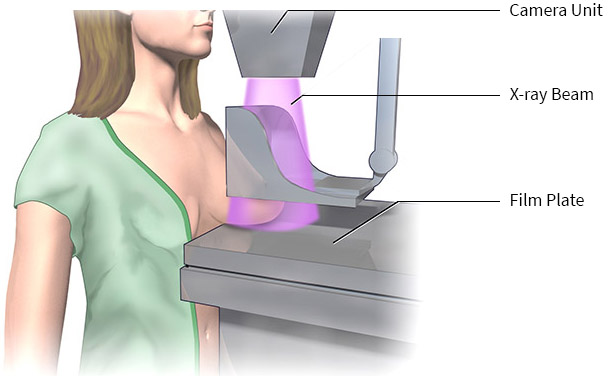Mammography
What is mammography?
- Mammography is X-Ray imaging of the breast
How is mammography of the breast useful?
- There are two main uses of mammography namely
- Screening Mammography Mammography is used to screen patients for breast cancer and it can be used to detect very early lesions which may not even be felt while palpating the breast. By detecting cancer early in the breast, the morbidity and mortality from breast cancer grossly reduces. Although we do not have national guidelines in India regarding screening for breast cancer in India yet, U.S Department of Health and Human Services (HHS) and the American College of Radiology (ACR) recommend screening mammography every year for women beginning at age 40.
- Diagnostic Mammography Diagnostic Mammography is used to detect breast cancer when a patient has an abnormal clinical finding such as a breast lump or nipple discharge and is used to guide treatment regarding the same.
How should I prepare for the mammography?
- There are certain instructions to be done before coming for the mammography test. They are
- Try not to schedule your appointment for mammography just before your menstrual period if your breasts hurt and are very tender at that time.
- Do not wear deodorant, talcum powder or lotion under your arms or on your breasts on the day of the exam. They can appear on the mammogram as calcium spots.
- Bring your previous mammogram reports as we may need to compare the present mammogram with the previous mammograms.
How does a mammography machine work?

- During mammography, a specially qualified radiographer will position your breast on a special platform on the mammography machine and will then compress your breast. X rays will then be passed through the breast to take the image. This is done in two positions, namely from above to below and sideways. The breast is compressed because
- To even out the breast so that all tissues in the breast can be visualised
- To allow a lower X-ray dose since a thinner amount of breast tissue is being imaged.
- Hold the breast still to minimise blurring of images caused by motion.
- Reduce X-ray scatter to increase the sharpness of the picture.
What will I experience during and after the procedure?
- As the breast is compressed by the machine, women who have a sore or tender breast may find it uncomfortable and may have some discomfort. If your breasts are tender during a particular time of the menstrual cycle, refrain from scheduling your appointment at that time and schedule your appointment at a time that will be comfortable for you.
Is the radiation exposure safe?
- The amount of radiation that is emitted during mammography is so low that it safe to undergo a mammogram. Please do inform the doctor or a technician if you are pregnant so that this test can be avoided
What are the limitations of a mammogram?
- Mammograms are very difficult to read when a woman has got a dense breast, i.e. when the amount of glandular tissue in the breast is very high.
- False negative results : With mammograms around 5 % of tumours may not be detected due to various reasons like dense breasts or if the malignant tissue is not clear on the mammograms.
- False positive results : 5 to 15% of women may have features suggestive of cancer which may need additional tests like ultrasound or MRI to prove they are not cancer. Still, this is better than to miss cancer that could be detected early.
What are the other cancers that can commonly be detected early by screening?
- There are many other cancers that can be found out early by screening such as using Pap Smear for cervical cancer, Prostate Specific Antigen (PSA) for prostate cancer, Colonoscopy for colon cancer, UGI scope for oesophagal cancers and CT scan for lung cancers in people who have a very high risk.




